2014 MERCEDES-BENZ B-CLASS SPORTS run flat
[x] Cancel search: run flatPage 316 of 360
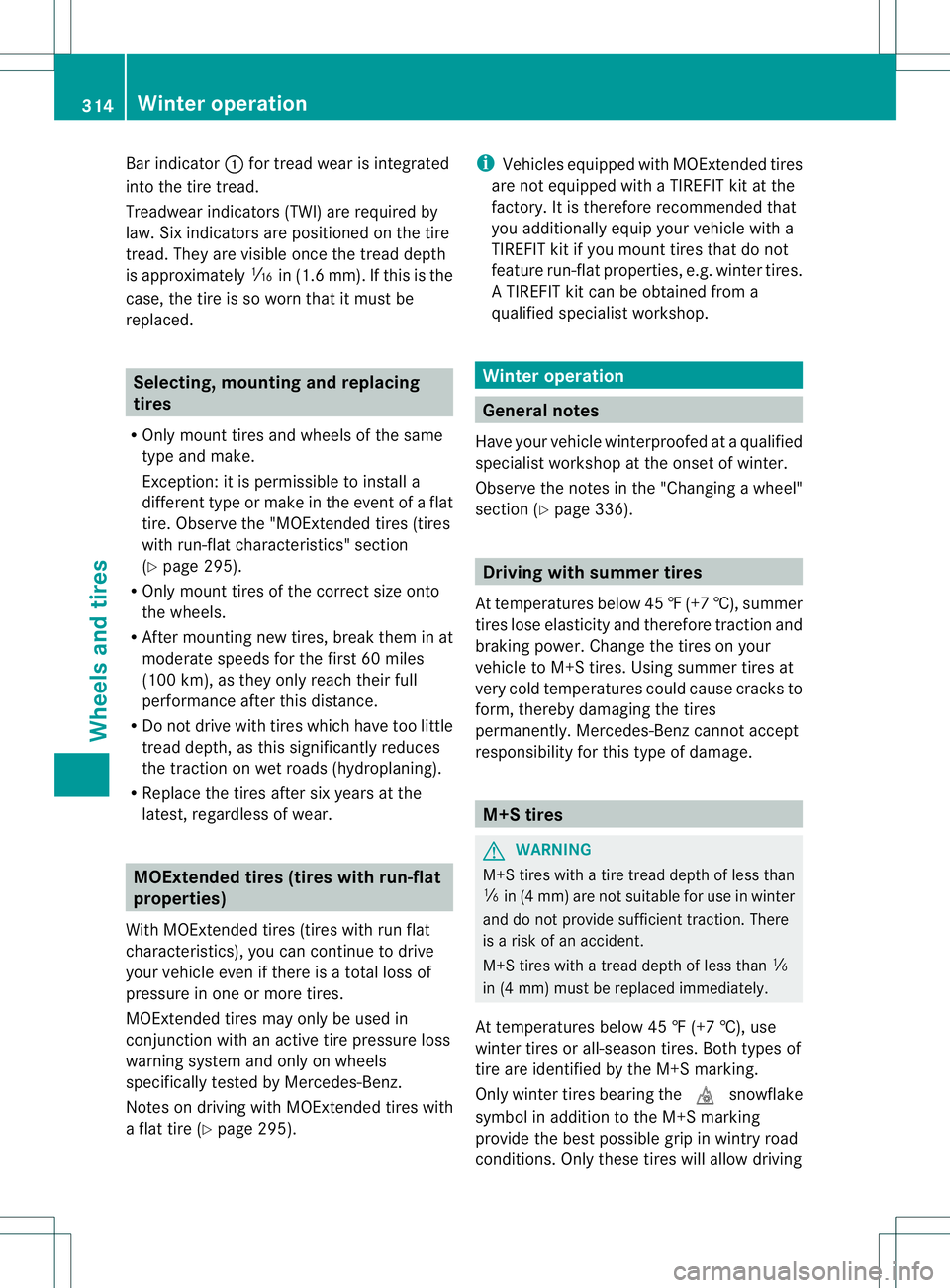
Bar indicator
001Afor trea dwearisi ntegrated
into the tire tread.
Treadwear indicator s(TWI) are required by
law. Six indicator sare positioned on the tire
tread. The yare visible once the trea ddepth
is approximately 0003in (1.6 mm). If this is the
case ,the tire is so worn that it mus tbe
replaced. Selecting, mounting and replacing
tires
R Only mount tires and wheels of the same
type and make.
Exception: it is permissible to install a
different type or make in the event of aflat
tire. Observe the "MOExtended tires (tires
with run-flat characteristics" section
(Y page2 95).
R Only mount tires of the correct size onto
the wheels.
R After mounting new tires, brea kthem in at
moderate speeds for the first 60 miles
(100 km), as they only reach their full
performance after this distance.
R Do not drive with tires which have too little
tread depth, as this significantly reduces
the traction on wet roads (hydroplaning).
R Replace the tires after six years at the
latest, regardless of wear. MOExtended tires (tires with run-flat
properties)
With MOExtended tires (tires with run flat
characteristics), you can continue to drive
your vehicle even if there is atotal loss of
pressure in one or more tires.
MOExtended tires may only be used in
conjunction with an active tire pressure loss
warning system and only on wheels
specifically tested by Mercedes-Benz.
Notes on driving with MOExtended tires with
af lat tire (Y page 295). i
Vehicles equipped with MOExtended tires
are not equipped with aTIREFIT kit at the
factory. It is therefore recommended that
you additionallye quip your vehicle with a
TIREFIT kit if you mount tires that do not
feature run-flat properties, e.g. winter tires.
AT IREFIT kit can be obtained from a
qualified specialist workshop. Winter operation
General notes
Have your vehicle winterproofed at aqualified
specialist workshop at the onset of winter.
Observe the notes in the "Changing awheel"
section (Y page 336). Driving with summer tires
At temperatures below 45 ‡(+7 †), summer
tires lose elasticity and therefore traction and
braking power. Change the tires on your
vehicle to M+S tires. Using summe rtires at
very cold temperatures coul dcause cracks to
form, thereb ydamaging the tires
permanently. Mercedes-Benz cannot accept
responsibility for this type of damage. M+S tires
G
WARNING
M+S tires with atire tread depth of less than
0015 in (4 mm) are not suitabl efor use in winter
and do not provide sufficient traction. There
is ar isk of an accident.
M+S tires with atread depth of less than 0015
in (4 mm) must be replaced immediately.
At temperatures below 45 ‡(+7 †), use
winter tires or all-season tires. Both type sof
tire are identified by the M+S marking.
Only winter tires bearing the 000Esnowflake
symbol in addition to the M+S marking
provide the best possibl egrip in wintry road
conditions. Only these tires will allow driving 314
Winte
roperationWheels and tires
Page 321 of 360
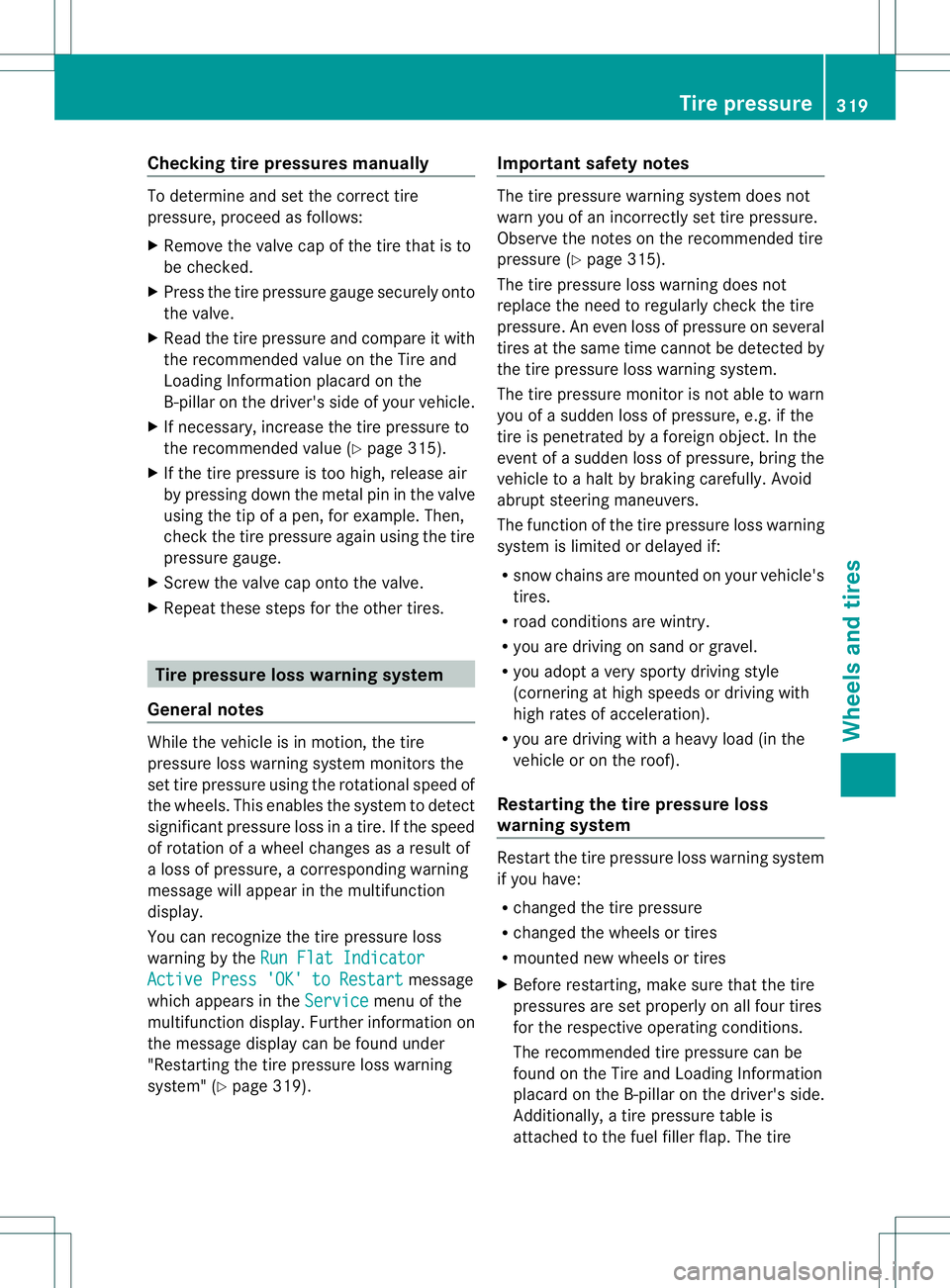
Checking tir
epressures manually To determine and set th
ecorrec ttire
pressure ,procee dasfollows:
X Remove th evalvec ap of th etiret hatisto
be checked.
X Press th etirep ressure gauge securely onto
th ev alve.
X Read th etirep ressure and compar eitwith
th er ecommended value on th eTire and
Loading Information placard on the
B-pillar on th edriver' sside of your vehicle.
X If necessary, increas ethe tirep ressure to
th er ecommended value ( Ypage 315).
X If th etirep ressure is to ohigh,release air
by pressin gdown th emetal pin in th evalve
usin gthe tip of apen,for example .Then,
check the tire pressure again using the tire
pressure gauge.
X Screw the valve cap onto the valve.
X Repeatt hese steps for the other tires. Tire pressurel
oss warning system
General notes While the vehicle is in motion, the tire
pressure loss warning system monitors the
set tire pressure using the rotational speed of
the wheels. This enables the system to detect
significant pressure loss in atire. If the speed
of rotation of awheel changes as aresult of
al oss of pressure, acorresponding warning
message will appearint he multifunction
display.
You can recognizet he tire pressure loss
warning by the Run Flat Indicator Active Press 'OK' to Restart message
which appears in the Service menu of the
multifunction display. Further information on
the message displayc an be found under
"Restarting the tire pressure loss warning
system" (Y page 319). Important safety notes The tire pressure warning system does not
warn you of an incorrectly set tire pressure.
Observe the notes on the recommended tire
pressure (Y
page 315).
The tire pressure loss warning does not
replace the need to regularly check the tire
pressure. An even loss of pressure on several
tires at the same time cannot be detected by
the tire pressure loss warning system.
The tire pressure monitor is not able to warn
you of asudden loss of pressure, e.g. if the
tire is penetrated by aforeign object.Int he
event of asudden loss of pressure, bring the
vehicle to ahalt by braking carefully. Avoid
abrupt steering maneuvers.
The function of the tire pressure loss warning
system is limited or delayed if:
R snow chains are mounted on your vehicle's
tires.
R road conditionsa re wintry.
R you are driving on sand or gravel.
R you adopt avery sporty driving style
(corneringath igh speeds or driving with
high rates of acceleration).
R you are driving with aheavy load (in the
vehicle or on the roof).
Restarting the tire pressurel oss
warning system Restart the tire pressure loss warning system
if you have:
R
changed the tire pressure
R changed the wheels or tires
R mounted new wheels or tires
X Before restarting, make sure that the tire
pressures are set properly on all four tires
for the respective operating conditions.
The recommended tire pressure can be
found on the Tire and Loading Information
placard on the B-pillar on the driver's side.
Additionally, atire pressure table is
attached to the fuel filler flap. The tire Tire pressure
319Wheels and tires Z
Page 322 of 360
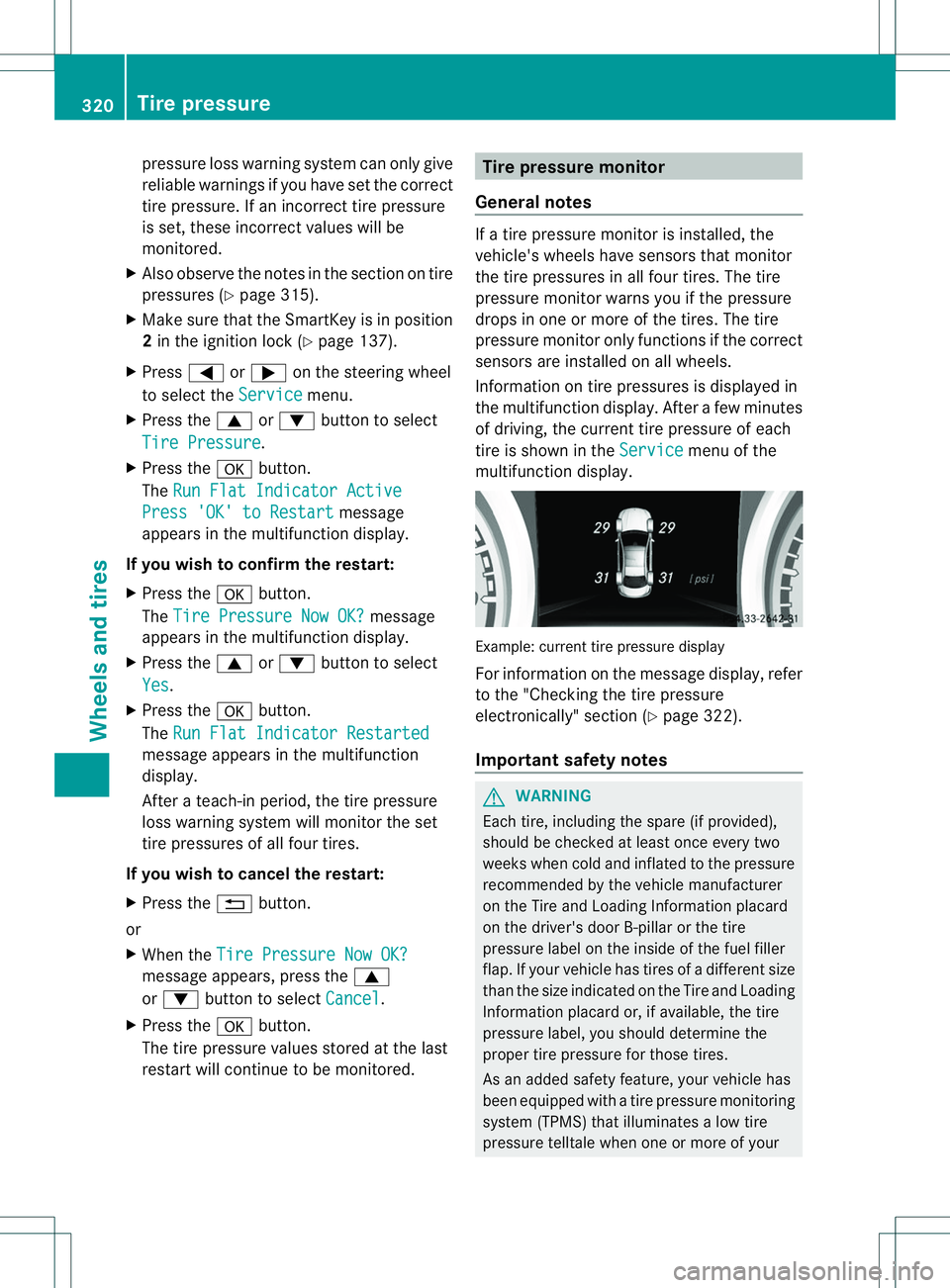
pressure loss warning system can only give
reliable warning
sifyou have set the correct
tire pressure. If an incorrec ttire pressure
is set, these incorrec tvalues will be
monitored.
X Als oobserv ethe note sinthesectio nontire
pressures (Y page 315).
X Make sure that the SmartKey is in position
2in the ignition lock (Y page 137).
X Press 000Aor0004 on the steerin gwheel
to selec tthe Service menu.
X Press the 0006or0005 button to select
Tire Pressure .
X Press the 000Cbutton.
The Run Flat Indicator Active Press 'OK' to Restart message
appears in the multifunction display.
If you wish to confirm the restart:
X Press the 000Cbutton.
The Tire Pressure Now OK? message
appears in the multifunction display.
X Press the 0006or0005 button to select
Yes .
X Press the 000Cbutton.
The Run Flat Indicator Restarted message appears in the multifunction
display.
After
ateach-in period, the tire pressure
loss warning system will monitor the set
tire pressures of all four tires.
If you wish to cancel the restart:
X Press the 0002button.
or
X When the Tire Pressure Now OK? message appears, press the
0006
or 0005 button to select Cancel .
X Press the 000Cbutton.
The tire pressure values stored at the last
restart will continue to be monitored. Tire pressurem
onitor
General notes If
at ire pressure monitor is installed, the
vehicle's wheels have sensors that monitor
the tire pressures in all four tires. The tire
pressure monitor warns you if the pressure
drops in one or more of the tires. The tire
pressure monitor only functions if the correct
sensors are installed on all wheels.
Information on tire pressures is displayed in
the multifunction display. After afew minutes
of driving, the current tire pressure of each
tire is shown in the Service menu of the
multifunction display. Example: current tire pressure display
For information on the message display, refer
to the "Checking the tire pressure
electronically"s
ection (Ypage 322).
Important safety notes G
WARNING
Each tire, including the spare (if provided),
should be checked at least once every two
weeks when cold and inflated to the pressure
recommended by the vehicle manufacturer
on the Tire and Loading Information placard
on the driver's door B-pillar or the tire
pressure label on the inside of the fuel filler
flap. If your vehicle has tires of adifferent size
than the size indicated on the Tire and Loading
Information placard or, if available, the tire
pressure label, you should determine the
proper tire pressure for those tires.
As an added safety feature, your vehicle has
been equipped with atire pressure monitoring
system (TPMS) that illuminates alow tire
pressure telltale when one or more of your 320
Tire pressureWheels and tires
Page 338 of 360
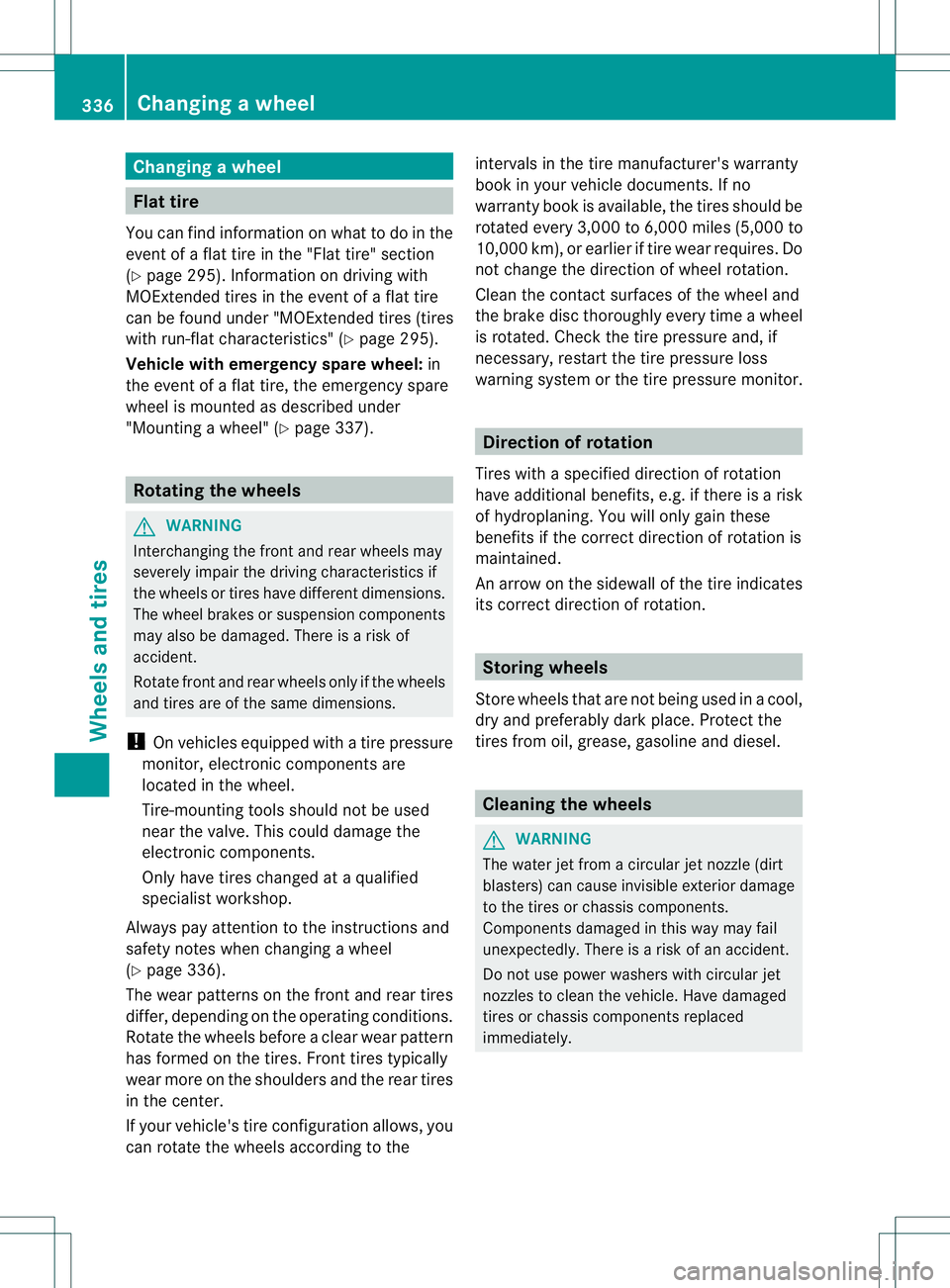
Changing
awheel Flat tire
You can find information on wha ttodointhe
event of aflat tire in the "Flat tire" section
(Y page 295). Information on driving with
MOExtended tires in the event of aflat tire
can be found under "MOExtended tires (tires
with run-flat characteristics" (Y page 295).
Vehicle with emergency sparew heel:in
the event of aflat tire, the emergenc yspare
wheel is mounted as described under
"Mounting awheel" ( Ypage 337). Rotating the wheels
G
WARNING
Interchangin gthe front and rear wheels may
severely impair the driving characteristics if
the wheels or tires have different dimensions.
The wheel brakes or suspension components
may also be damaged. There is arisk of
accident.
Rotate front and rear wheels only if the wheels
and tires are of the same dimensions.
! On vehicles equipped with atire pressure
monitor, electronic components are
located in the wheel.
Tire-mounting tools should not be used
near the valve. This could damage the
electronic components.
Only have tires changed at aqualified
specialist workshop.
Always pay attention to the instructions and
safety notes when changing awheel
(Y page 336).
The wear pattern sonthe front and rear tires
differ, depending on the operating conditions.
Rotate the wheels before aclear wear pattern
has formed on the tires. Frontt ires typically
wear more on the shoulders and the rear tires
in the center.
If your vehicle's tire configuration allows, you
can rotatet he wheels according to the intervals in the tire manufacturer's warranty
book in your vehicle documents. If no
warranty book is available, the tires should be
rotated every 3,000 to 6,000 miles
(5,000 to
10,000 km), or earlier if tire wear requires. Do
not change the direction of wheel rotation.
Clean the contac tsurface softhe wheel and
the brake disc thoroughly every time awheel
is rotated. Check the tire pressure and, if
necessary, restart the tire pressure loss
warning system or the tire pressure monitor. Direction of rotation
Tires with aspecified direction of rotation
have additional benefits, e.g. if there is arisk
of hydroplaning. You will only gain these
benefits if the correct direction of rotation is
maintained.
An arrow on the sidewall of the tire indicates
its correct direction of rotation. Storing wheels
Storew heels that are not being used in acool,
dry and preferably dark place. Protect the
tires from oil, grease, gasoline and diesel. Cleaningt
he wheels G
WARNING
The water jet from acircular jet nozzle (dirt
blasters) can cause invisible exterior damage
to the tires or chassis components.
Components damaged in this way may fail
unexpectedly. There is arisk of an accident.
Do not use power washers with circular jet
nozzles to clean the vehicle. Have damaged
tires or chassis components replaced
immediately. 336
Changing
awheelWheels and tires
Page 340 of 360
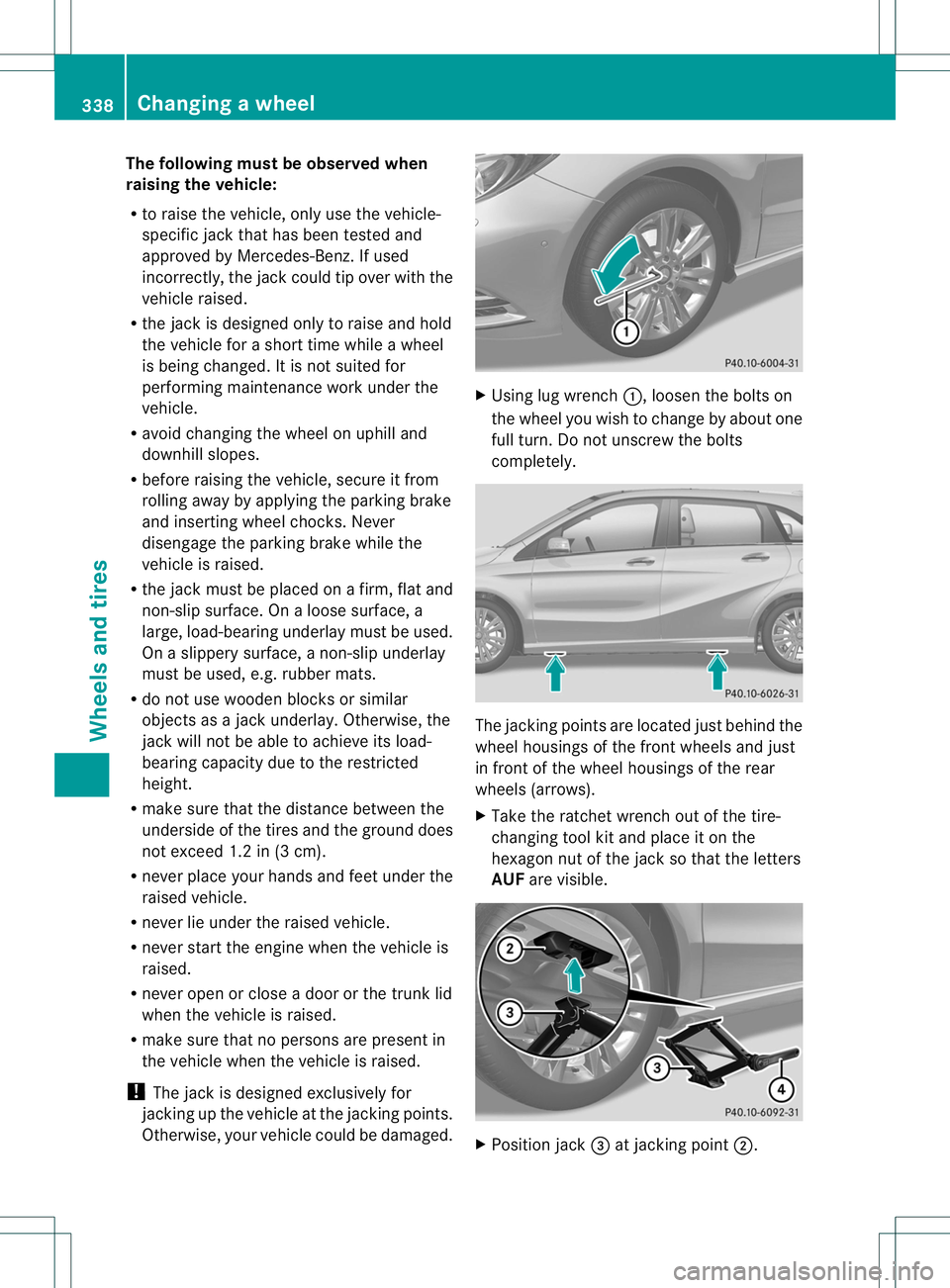
The followin
gmust be observe dwhen
raisin gthe vehicle:
R to raise the vehicle, only use the vehicle-
specific jack that has been tested and
approved by Mercedes-Benz. If used
incorrectly ,the jack coul dtip over with the
vehicle raised.
R the jack is designed only to raise and hold
the vehicle for ashort time while awheel
is being changed .Itisnot suited for
performing maintenance work under the
vehicle.
R avoid changing the wheel on uphilla nd
downhill slopes.
R before raising the vehicle, secure it from
rolling awaybya pplying the parking brake
and inserting wheel chocks. Never
disengage the parking brake while the
vehicle is raised.
R the jack must be placed on afirm, flat and
non-slip surface. On aloose surface, a
large, load-bearing underlay must be used.
On aslippery surface, anon-slip underlay
must be used, e.g. rubber mats.
R do not use wooden blocks or similar
objects as ajack underlay.O therwise, the
jack will not be able to achieve its load-
bearing capacity du etothe restricted
height.
R make sure tha tthe distance between the
underside of the tires and the ground does
not exceed 1.2 in (3 cm).
R never place your hands and feet under the
raised vehicle.
R never lie under the raised vehicle.
R never start the engine when the vehicle is
raised.
R never open or close adoor or the trunk lid
when the vehicle is raised.
R make sure that no persons are present in
the vehicle when the vehicle is raised.
! The jack is designed exclusively for
jackingupt he vehicle at the jackingp oints.
Otherwise, your vehicle could be damaged. X
Using lug wrench 001A,loosen the bolts on
the wheel you wish to change by about one
full turn. Do not unscrew the bolts
completely. The jackingp
oints are located just behind the
wheel housings of the front wheels and just
in front of the wheel housings of the rear
wheels (arrows).
X Take the ratchet wrench out of the tire-
changing tool kit and place it on the
hexagon nut of the jack so that the letters
AUF are visible. X
Position jack 0023at jackingp oint0010. 338
Changing
awheelWheels and tires
Page 342 of 360
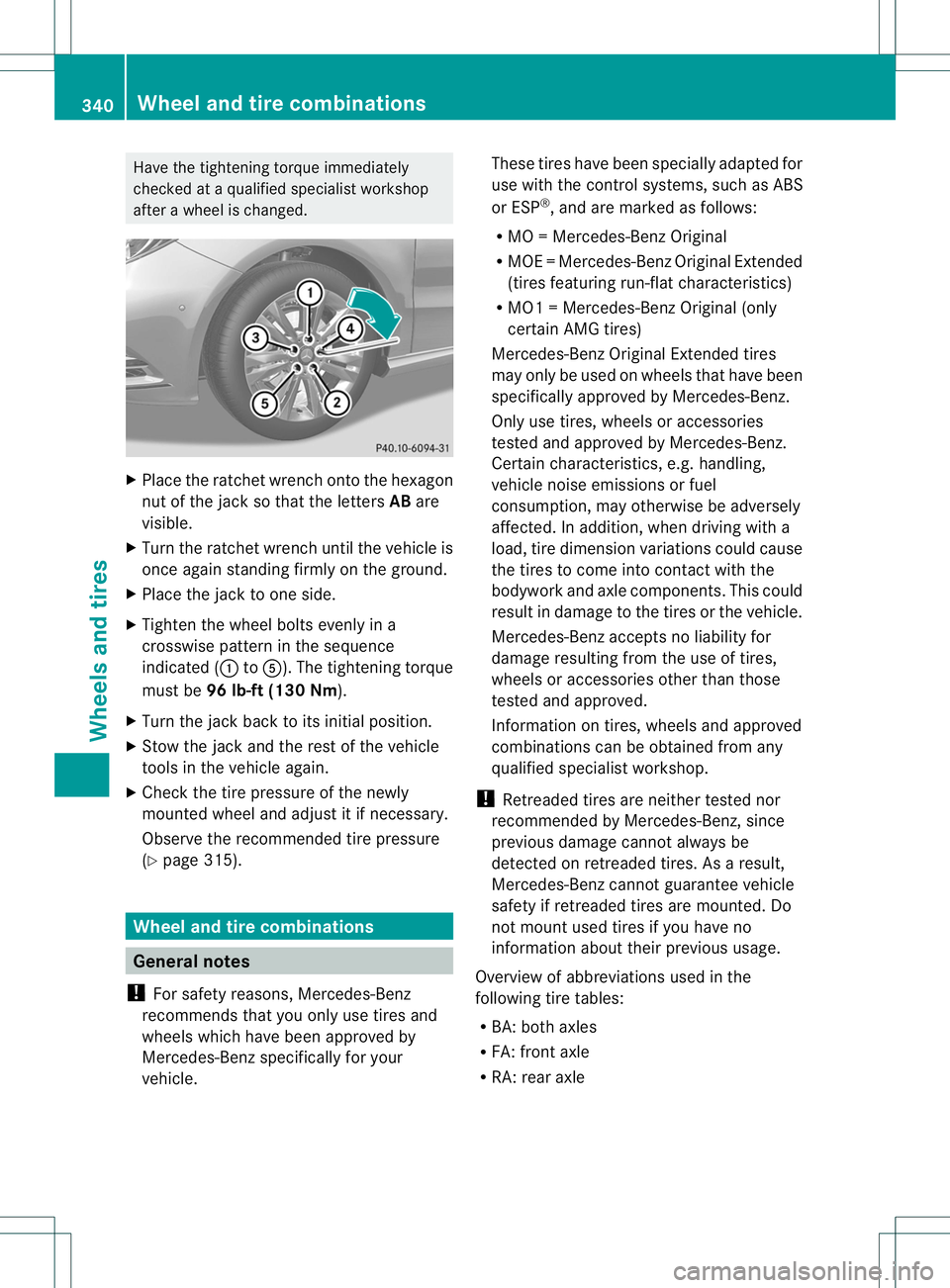
Have the tightening torqu
eimmediately
checked at aqualifie dspecialist workshop
after awheel is changed. X
Place the ratche twrench onto the hexagon
nut of the jack so that the letters ABare
visible.
X Turn the ratchet wrench until the vehicl eis
once again standing firmly on the ground.
X Place the jack to one side.
X Tighten the whee lbolts evenly in a
crosswise pattern in the sequence
indicated ( 001Ato001E). The tightening torque
must be 96 lb-ft (130Nm ).
X Turn the jack back to its initia lposition.
X Stow the jack and the rest of the vehicle
tools in the vehicl eagain.
X Check the tire pressure of the newly
mounted whee land adjust it if necessary.
Observe the recommende dtire pressure
(Y page3 15). Wheel and tire combinations
General notes
! For safety reasons, Mercedes-Benz
recommends that you only use tires and
wheels which have been approved by
Mercedes-Benz specifically for your
vehicle. These tires have been speciallya
dapted for
use with the control systems ,such as ABS
or ESP ®
,a nd are marked as follows:
R MO =Mercedes-BenzO riginal
R MOE =Mercedes-BenzO riginal Extended
(tires featuring run-flat characteristics)
R MO1 =Mercedes-BenzO riginal (only
certain AMG tires)
Mercedes-Benz Original Extended tires
may only be used on wheels that have been
specificall yapproved by Mercedes-Benz.
Only use tires, wheels or accessories
tested and approved by Mercedes-Benz.
Certain characteristics, e.g. handling,
vehicl enoise emissions or fuel
consumption, may otherwise be adversely
affected. In addition, when driving with a
load, tire dimension variations coul dcause
the tires to come into contact with the
bodywork and axle components. This could
resul tind amage to th etires or th evehicle.
Mercedes-Ben zaccepts no liability for
damag eresulting from the us eoftires,
wheel soraccessorie sothe rthan those
tested and approved.
Information on tires, wheels and approved
combinations can be obtained from any
qualified specialist workshop.
! Retreaded tires are neither tested nor
recommended by Mercedes-Benz, since
previous damage cannot always be
detected on retreaded tires. As aresult,
Mercedes-Ben zcannot guarante evehicle
safety if retreade dtires are mounted. Do
no tm ount used tires if you have no
information about their previous usage.
Overview of abbreviations used in the
following tire tables:
R BA: both axles
R FA: front axle
R RA: rear axle 340
Wheel and tirec
ombinationsWheels and tires
Page 343 of 360
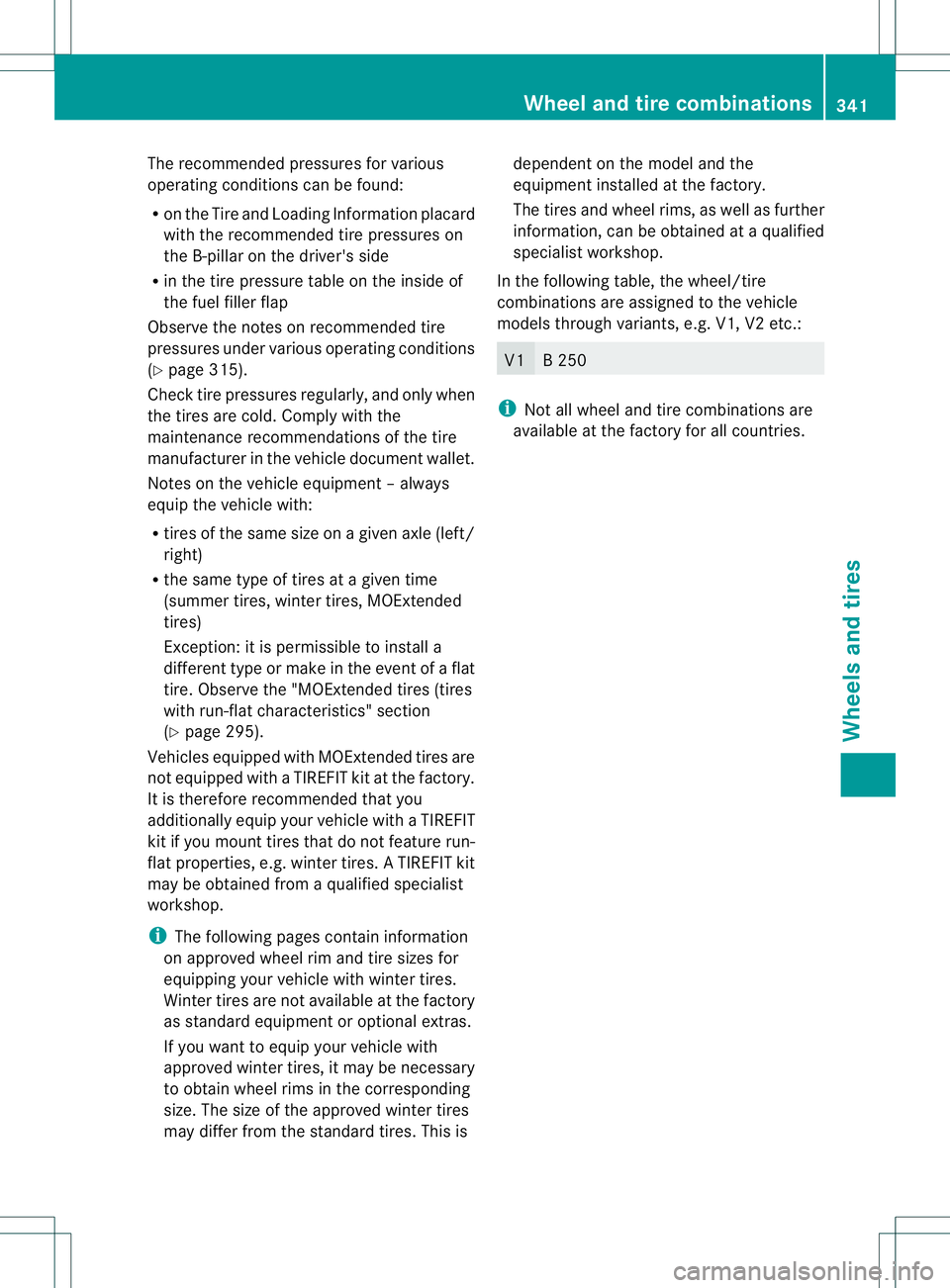
The recommended pressures for various
operating conditions can be found:
R
on the Tire and Loading Information placard
with the recommended tire pressures on
the B-pillar on the driver's side
R in the tire pressure table on the inside of
the fuel filler flap
Observe the notes on recommended tire
pressures under various operating conditions
(Y page 315).
Check tire pressures regularly, and only when
the tires are cold. Comply with the
maintenance recommendations of the tire
manufacturer in the vehicle document wallet.
Notes on the vehicle equipment –always
equip the vehicle with:
R tires of the same size on agiven axle (left/
right)
R the same type of tires at agiven time
(summer tires, winter tires, MOExtended
tires)
Exception: it is permissible to install a
differen ttype or mak einthe event of aflat
tire. Observe the "MOExtended tires (tires
with run-flat characteristics" section
(Y page 295).
Vehicles equipped with MOExtended tires are
not equipped with aTIREFIT kit at the factory.
It is therefore recommended that you
additionall yequip your vehicle with aTIREFIT
kit if you mount tires that do not feature run-
flat properties, e.g. winter tires. ATIREFIT kit
may be obtained from aqualified specialist
workshop.
i The following pagesc ontain information
on approved wheelr im and tire sizes for
equipping yourv ehicle with winter tires.
Winter tires are not available at the factory
as standard equipment or optional extras.
If you want to equip your vehicle with
approved winter tires, it may be necessary
to obtain wheel rims in the corresponding
size. The size of the approved winter tires
may differ from the standard tires. This is dependen
tonthe model and the
equipment installed at the factory.
The tires and wheel rims, as well as further
information ,can be obtained at aqualified
specialist workshop.
In the following table, the wheel/tire
combinations are assigned to the vehicle
models through variants, e.g. V1, V2 etc.: V1 B2
50 i
Not all wheel and tire combinations are
available at the factory for all countries. Wheel and tire combinations
341Wheels and tires Z